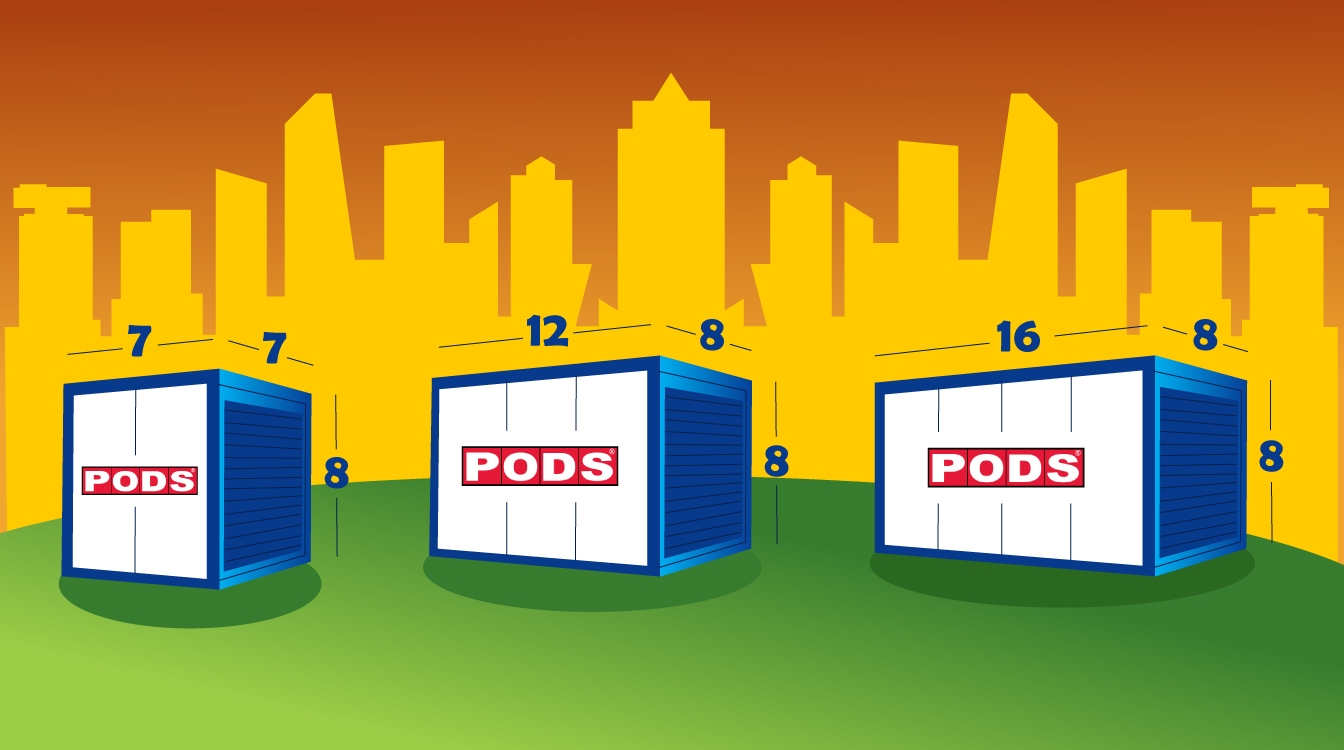PODS Sizes: How To Choose the Right Container for Your Move
What are the different PODS sizes? PODS containers offer a convenient solution for hybrid or DIY long-distance moves, with three sizes available: eight-foot, 12-foot, and 16-foot. Choosing the right size is crucial to avoid overpaying or running out of space.
Small containers suit studio apartments, medium containers fit one-bedroom homes, and large containers are best for two to three bedrooms. PODS are highly rated for their ease of use, secure storage, and professional service, making them a popular choice among moveBuddha readers.
Check out this guide for a quick primer on PODS sizes. We’ll break down average PODS costs and provide expert tips on safely transporting your stuff in a POD.
89% of users select this mover
Quickly find your PODS size
Not sure which PODS size to book? Here’s a general guide for sizing:
| Bedrooms | Container | Dimensions |
|---|---|---|
| Studio apartment (500 square feet) | 8-foot container (small) | 8 feet x 7 feet x 8 feet |
| One-bedroom house (500–800 square feet) | 12-foot container (medium) | 12 feet x 8 feet x 8 feet |
| Two- or three-bedroom house (1,200 square feet) | 16-foot container (large) | 16 feet x 8 feet x 8 feet |

Reasons to rent a PODS container
Whether you’re moving or need storage, there are so many reasons to rent a PODS container:
- When looking at PODS vs. moving companies, PODS are much cheaper than full-service movers
- You don’t want to drive a rental truck through cities, mountains, ice, or snow
- If you’re not ready to move into your new place just yet, PODS will store your container securely until you’re ready to move in
- You want to take your time loading and unloading
While there are plenty of moving container companies on the market, moveBuddha readers rate PODS highly for several reasons:
- They’re available for in-town, long-distance, and interstate moves
- PODS offers storage if you need it
- PODS containers are strong, weather-resistant, and secure. According to PODS, their containers can withstand winds of up to 100 miles per hour.
- Enjoy easy ground-level loading and unloading — no ramps required
- 30 days storage included
- Local and long distance moving options
- Unlimited loading/unloading time
- Store on property or at a facility
PODS sizes
PODS containers come in three sizes: eight feet (small), 12 feet (medium), and 16 feet (large). Check out their dimensions to see which moving container size fits your move.
Eight-foot containers
12-foot containers
16-foot containers
PODS cost
The cost of PODS depends on several factors. Here’s a quick breakdown of average PODS costs:
| Distance | 1 bedroom | 2-3 bedrooms | 4-5 bedrooms |
|---|---|---|---|
| Local (>50 miles) | $225–$435 | $345–$650 | $330–$830 |
| Long distance (up to 250 miles) | $460–$845 | $760–$1,970 | $930–$2,150 |
| Cross country | $2,110–$4,110 | $3,060–$4,960 | $5,550–$7,660 |
PODS might be a little pricier than other moving containers, but you get a lot for the money. PODS’ base pricing includes mileage and fuel and one month of storage on your property. Delivery is always $89.99, regardless of the PODS size you book. If you need extra storage, pricing starts at $149 per month.
But keep in mind that these prices are just estimates. The cost of your move could be more or less, depending on other factors unique to your move. For example, buying moving services or packing materials will drive up your costs.
So many factors play into moving costs, but PODS pricing depends on things like:
- The container size you book
- How many containers you use
- The distance between your old and new home
How do PODS work?
PODS is a flexible moving container option you can use for onsite and offsite storage. Think of it as a portable storage container — without the commitment — for local, long-distance, and interstate moves.
| Company | Quote | Rating | Price |
|---|---|---|---|
U-Pack 
|
Check prices |
|
|
1-800-Pack-Rat 
|
Check prices |
|
|
Moving Place 
|
Check prices |
|
PODS are more cost-effective than hiring full-service movers. While you’re on the hook for loading and unloading, professionals will handle all of the driving for you.
Here’s how the PODS rental process works, regardless of the PODs size you want to use:
- Decide on a moving date and location. Make sure PODS is legal in both your current and new city. Some cities have strict rules about parking PODS on the street, in parking spaces, or even in private driveways, so check all ordinances before booking.
- If you need storage, figure out how long you’ll need it. You also need to decide if you want to store the PODS at your house or a PODS storage facility.
- Take some rough measurements to determine the size and amount of PODS you need to book.
- Visit the PODS website and request a free quote.
- Reserve your container online or over the phone and schedule the delivery date.
- On delivery day, PODS will show up with a truck to deliver the container to your home, apartment, or business. They use the proprietary PODZILLA system to gently lower the PODS into your designated delivery area.
- You and your helpers will load the items into the PODS at your own pace.
- When you’re done, schedule a pickup time with PODS. A driver will pick up the container on your designated day and take it to your new home or the POD storage facility.
- You unload the PODS after container delivery and notify the company when you’ve emptied the PODS. They’ll pick it up on your scheduled day, and that’s it!
Check out our full PODS review to see what our Better Moves Project participants had to say about the company’s rental process.
How are PODS built?
PODS move a lot, so they have to be strong and durable. Fortunately, all PODS containers are sturdy.
These steel containers have solid wood interior walls and impact-resistant polymers, which makes them strong, secure, and weather-resistant. So don’t worry — your belongings will typically be safe and dry inside the POD, so long as you pack and load your items carefully.
The only thing you need to worry about is temperature and humidity. Like all storage containers, your items will be susceptible to dramatic changes in temperature and humidity. Condensation from the air and ground is also a concern.
To protect your stuff, use shrink wrap and additional layers of packing or moving materials. Sensitive items like instruments might need anti-moisture packets or insulated box liners.
|
|
|
|
|
|
Loading your PODS container
Loading the PODS is more seamless than heaving a couch up a ramp or onto a rented moving truck. PODS containers are at ground level, so there’s no need to fuss with a ramp or stairs.
Balancing the weight correctly is definitely how you should pack a POD. If you put all the weight on one side of the moving container, it could go off balance mid-air or in storage, damaging your belongings.
Spread heavier items like sofas and dressers as evenly as possible to distribute the weight. Be sure to load the items you’ll need to access first near the door.
This usually includes items like:
- Toiletries
- Clothes
- Mattresses and bedding
- Dishes and cookware
- Appliances
- Toys
- Tools
PODS is a safe moving method, but things can happen. Keep important documents, like passports, medical records, IDs, and birth certificates on your person during the move.
PODS tips
moveBuddha readers rate PODS highly as a professional, friendly moving container solution. Here are a few tricks you can use to make your PODS experience even better:
- Book ahead. Reserve your container and pickup and delivery dates at least a week or two in advance. That goes double if you book during the peak summer months.
- When in doubt, go big. If you aren’t sure which PODS size works best for your move, choose the larger option. It’s always better to have a little more room than not enough.
- Use the right packing materials. Odd-sized or misshapen packing materials make it harder to load your unit effectively. Use standard moving boxes or plastic bins to pack your unit more efficiently. This also makes it easier to utilize the POD’s vertical space.
- Stock up on supplies. You’re in charge of packing and loading, so start gathering moving supplies. Get packing paper, tape, moving blankets, and boxes. Rope is also a good option to tie down items that may shift during transport. You can buy these materials, but they’re a little pricey. Find cheap moving boxes and other supplies by asking friends or family or checking sites like Nextdoor and Craigslist.
- Ask about discounts. PODS offers news customers 10% off their initial delivery and 10% off of their first month’s rental for local moves. For long-distance moves, news customers also get 10% off initial delivery, 10% off first month’s rental, and 10% off long-distance transportation. That said, it is always important to call the company to ask additional coupons or special promotions before reserving your PODS container.
- Communicate with PODS. Hey, life happens. If your moving dates change, notify PODS immediately to avoid confusion and additional costs.
- Be available. Clear your schedule so you can meet the PODS driver in person for drop-off and pickup. This ensures they drop off the container at the right place and position. You won’t be able to move the container yourself after the fact, so this is crucial for a hassle-free experience.
- Pick a good spot for your POD. Find a suitable place on your street or in your yard or driveway for the POD. Some cities have ordinances against moving containers, particularly in the street, so check your local laws before booking with PODS.
89% of users select this mover
What can’t you pack in a PODS?
PODS will transport a lot of things, but there are some items that PODS can’t accept.
Never pack these items in a PODS container:
- Cars and other motorized vehicles, including lawn mowers and tractors (check out some of the best car shipping companies if you need to move a vehicle)
- Hazardous materials
- Trash and garbage
- Guns, ammunition, and fireworks
- Propane and other compressed gas tanks
- Yard waste
- Paint, thinners, chemicals, and automotive liquids like oil, coolant, gasoline, and brake fluid
Please note that this isn’t a complete list, so check with PODS before signing a moving or storage contract.
FAQ about PODS sizes
What are the different sizes of PODS?
There are three different PODS sizes:
- Eight feet: The small POD is best for student or studio apartment moves.
- 12 feet: This size is only available for local moves. It’s best for one- or two-bedroom apartment moves.
- 16 feet: The largest POD size is good for a two- to three-bedroom family home. You’ll probably need more than one 16-foot POD if your home is larger than 1,200 square feet.
What fits in a 16-foot POD?
A 16-foot PODS container has 850 cubic feet of space, has a 4,200-pound weight limit, and can hold the contents of a 1,200-square-foot home. PODS’ 16-foot containers measure 16 feet long, 8 feet high, and 8 feet wide. It can hold larger furniture items — like sofas, beds, dressers, a dining room set — and several large boxes. If your shipment is primarily boxes, you should be able to fit approximately 225 boxes into a 16-foot POD. It’s also suitable for appliances like washers, dryers, and refrigerators. If your home is larger than 1,200 feet, you’ll probably want to book more than one 16-foot POD.
How much fits in a 12-foot POD?
12-foot PODS containers measure 12 x 8 x 8 feet and have about 690 cubic feet of interior space. To put that into perspective, it’s about 8% less room than a 15-foot U-Haul. 12-foot PODS containers are usually reserved for local moves and storage only.
12-foot containers are typically best for:
- Fully furnished 1 or 2-bedroom apartments
- Minimally furnished 2-bedroom homes
- Small office moves
- Storing equipment and material during a remodeling or home improvement project
What are the sizes and weight limits for PODS?
The eight-foot container can hold up to 5,200 pounds, while the 12-foot container can only hold 4,700 pounds. The 16-foot container holds 4,200 pounds.
It might sound counterintuitive, but the smaller footprint on the eight-foot POD makes it safer to move heavier items. The larger the POD’s footprint, the less weight it can carry.
What PODS size is the most popular?
The 16-foot POD is the most popular choice because it meets the needs of an average-sized family home. It’s versatile for large or small moves, whether you’re moving locally or across the country.
What size PODS should I get for my move?
Eight-foot PODS are best for small moves for students or studio apartments. Twelve-foot PODS are larger, but they’re only available for local moves, so it’s a good option if you need to move more space and are moving across town. Sixteen-foot PODS are ideal for moving a standard family home that’s around 1,200 square feet.
Not what you were looking for?
Check out other categories that can help you find the information you need!





